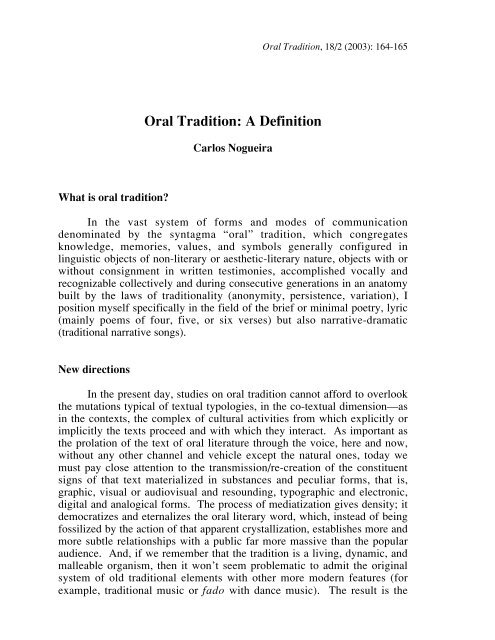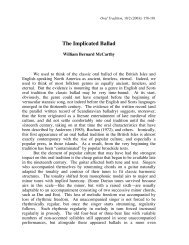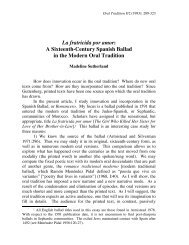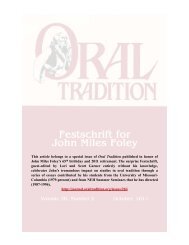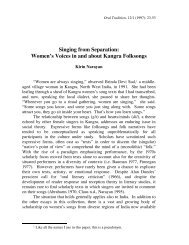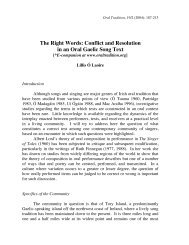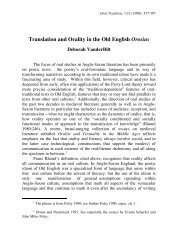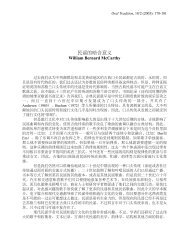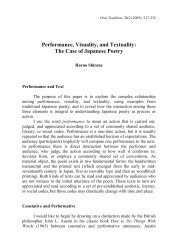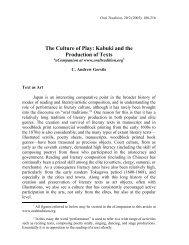Oral Tradition: A Definition - Oral Tradition Journal
Oral Tradition: A Definition - Oral Tradition Journal
Oral Tradition: A Definition - Oral Tradition Journal
Create successful ePaper yourself
Turn your PDF publications into a flip-book with our unique Google optimized e-Paper software.
What is oral tradition?<br />
<strong>Oral</strong> <strong>Tradition</strong>: A <strong>Definition</strong><br />
Carlos Nogueira<br />
<strong>Oral</strong> <strong>Tradition</strong>, 18/2 (2003): 164-165<br />
In the vast system of forms and modes of communication<br />
denominated by the syntagma “oral” tradition, which congregates<br />
knowledge, memories, values, and symbols generally configured in<br />
linguistic objects of non-literary or aesthetic-literary nature, objects with or<br />
without consignment in written testimonies, accomplished vocally and<br />
recognizable collectively and during consecutive generations in an anatomy<br />
built by the laws of traditionality (anonymity, persistence, variation), I<br />
position myself specifically in the field of the brief or minimal poetry, lyric<br />
(mainly poems of four, five, or six verses) but also narrative-dramatic<br />
(traditional narrative songs).<br />
New directions<br />
In the present day, studies on oral tradition cannot afford to overlook<br />
the mutations typical of textual typologies, in the co-textual dimension—as<br />
in the contexts, the complex of cultural activities from which explicitly or<br />
implicitly the texts proceed and with which they interact. As important as<br />
the prolation of the text of oral literature through the voice, here and now,<br />
without any other channel and vehicle except the natural ones, today we<br />
must pay close attention to the transmission/re-creation of the constituent<br />
signs of that text materialized in substances and peculiar forms, that is,<br />
graphic, visual or audiovisual and resounding, typographic and electronic,<br />
digital and analogical forms. The process of mediatization gives density; it<br />
democratizes and eternalizes the oral literary word, which, instead of being<br />
fossilized by the action of that apparent crystallization, establishes more and<br />
more subtle relationships with a public far more massive than the popular<br />
audience. And, if we remember that the tradition is a living, dynamic, and<br />
malleable organism, then it won’t seem problematic to admit the original<br />
system of old traditional elements with other more modern features (for<br />
example, traditional music or fado with dance music). The result is the
ORAL TRADITION: A DEFINITION 165<br />
appearance of products with artistic and pragmatic dimensions and with a<br />
memorial presence larger than that of its more ancient congeners.<br />
References<br />
Universidade de Lisboa<br />
Finnegan 1992 Ruth Finnegan. <strong>Oral</strong> Poetry: Its Nature, Significance and<br />
Social Context. Bloomington: Indiana University Press.<br />
Orig. publ. 1977.<br />
Ong 1995 Walter J. Ong. <strong>Oral</strong>ity and Literacy: The Technologizing<br />
of the World. London: Routledge.<br />
Zumthor 1979 Paul Zumthor. “Pour une poétique de la voix.” Poétique,<br />
40:514-24.<br />
Zumthor 1982<br />
Zumthor 1983<br />
Zumthor 1987<br />
. “Le discours de la poésie orale.” Poétique,<br />
52:387-401.<br />
Seuil.<br />
. Introduction à la poésie orale. Paris: Edition du<br />
. La Lettre et la voix. Paris: Edition du Seuil.


